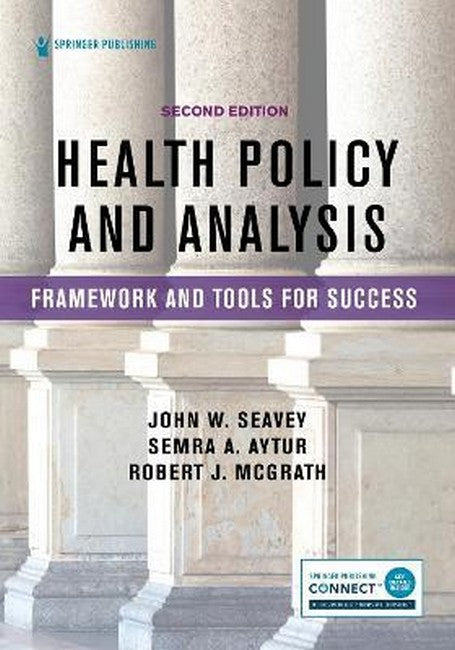John W. Seavey, MPH, PhD, is Professor Emeritus and past Everett B. Sackett Professor at the University of New Hampshire, Department of Health Management and Policy, College of Health and Human Services. Semra A. Aytur, PhD, MPH is a Professor in the Department of Health Management and Policy at the University of New Hampshire (UNH). Robert J. McGrath, PhD is the current Everett B. Sacket Professor and Chair of the Department of Health Policy and Management at the University of New Hampshire. He is also currently the director of the Graduate Programs in Health Data Science.
Request Academic Copy
Please copy the ISBN for submitting review copy form
Description
Preface Acknowledgments Chapter 1. Perspectives for Public Health Policy Analysis Determinants of Public Health Core Functions of Public Health Health in All Policies (HiAP) Summary Chapter 2. Elements and History of the US Political Structure The Need for Political Structure The Economic System and Market Failure Policy & Law American Historical Perspectives The Articles of Confederation & the Constitution General Structural Principles Separation of Powers Federalism Medicare/Medicaid and Affordable Health Care Delegated Powers Implied Powers Summary Chapter 3. The United States' Political Structure The Preamble The Legislative Branch State Legislatures The Executive Branch The President The Federal Bureaucracy The Office of the President The Cabinet The Civil Service State Executives The Judicial Branch The Federal Court System The State Court Systems Remaining Constitutional Provisions The Bill of Rights Freedom of Religion The Second Amendment The 9th Amendment Summary Chapter 4. The Political Process The Policy Making Process Procedural Democracy and Constitutional Democracy Democracy and Democratic Pluralism Factions Special Interest Groups & Lobbying Scope and Bias The Ability to Block Political Parties Incrementalism US Political Process Defined Summary Chapter 5. The American Maze The Legislative Process Staff Legislative Committees Introduction of a Policy Proposal Rules and Regulations Executive Orders The Judiciary States & Local Governments Summary Chapter 6. Political Culture The Nature of Political Culture Examples of the Dominant American Political Culture Non-Partisan Efforts Partisanship States and Local Political Cultures Summary Chapter 7. Beginning your Public Health Policy Analysis A Roadmap for Writing a Policy Analysis Report Consideration of Political Science Theory Assessing the Evidence Peer Reviewed Literature Grey Literature Engaging Key Stakeholders Some Specifics for Writing Your Report Table of Contents Executive Summary Definitions/Abbreviations References Other Appendices Summary Chapter 8. Health Policy Analysis Foundations Health Policy and Health Services Research Health Policy Analysis Evidence-Based Health Policy Effectiveness Efficiency Allocative and Production Efficiency Equity Feasibility Integrative Frameworks PRECEDE-PROCEED RE-AIM National Efforts of Health Policy Analysis Agency for Healthcare Research & Quality (AHRQ) The National Academy of Medicine (NAM); formerly The Institute of Medicine (IOM) Patient-Centered Outcomes Research Institute (PCORI) Centers for Disease Control and Prevention (CDC) The CDC Policy Research, Analysis, and Development Office Other Policy Research Institutes Summary Chapter 9. Health Data and Analytical Methods Public Data Analytical Studies Performing the Analysis The Data Ecosystem General Analytic Functions Artificial Intelligence (AI) and "Big Data" Tools The Unintended Impacts of Data Science Methods for Policy Analysis Data Gaps and their Biases Final Considerations Summary Chapter 10. Policy Background Section History The Obesity Issue Policy Significance Legal Authority/Flexibility Model Programs/Policies Relationships to Other Policy Issues Policy Agenda Summary Chapter 11. Statement of Policy Issue Policy Issue Statement What Does a Policy Issue Statement Look Like? Framing Summary Chapter 12. Stakeholder Analysis The Role of Values Example of Stakeholders in Child Obesity Stakeholder Analysis Tools for Stakeholder Analysis LFHK Washington State Summary Chapter 13. Criteria for Success Definition of Success Measurement Summary Chapter 14. Review of Policy Options Evidence When to Call It Quits Summary Chapter 15. Recommendation and Strategies Recommendation Legislative Strategies Administrative Strategies Litigation Strategy Summary Appendix

